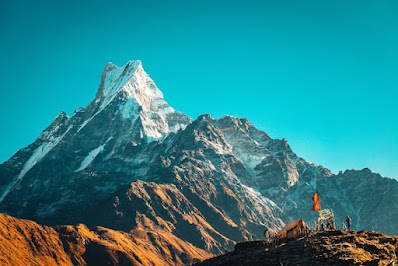The Himalayas, often referred to as the "abode of snow,"
form a majestic mountain range in Asia, spanning across several countries, including India, Nepal, Bhutan, China, and Pakistan. This colossal mountain system stretches over 1,500 miles and harbours some of the planet's most iconic peaks, with Mount Everest standing as the highest point on Earth, reaching an elevation of 29,032 feet (8,848 metres).
Geographical Features:
The Himalayas are a geological marvel, primarily formed by the collision of the Indian and Eurasian tectonic plates. This collision has led to the upliftment of the land, creating the awe-inspiring mountain range we see today. The region is characterised by deep valleys, high plateaus, and rugged landscapes, making it a challenging yet breathtaking terrain.
Biodiversity:
The Himalayas boast incredible biodiversity due to the variation in altitude and climate. The lower foothills are covered in lush forests, home to diverse flora and fauna. As you ascend, the vegetation changes, giving way to alpine meadows and, eventually, snow-covered peaks. Rare and endangered species, such as the snow leopard, red panda, and Himalayan tahr, find sanctuary in this unique ecosystem.
Cultural Significance:
Beyond their natural beauty, the Himalayas hold immense cultural significance. The region is a melting pot of diverse ethnicities, languages, and traditions. Various indigenous communities, such as the Sherpas and Tibetans, have thrived in these challenging terrains for centuries. The Himalayas are also revered in Hinduism and Buddhism, with many sacred sites scattered throughout the range.
Mount Everest:
Mount Everest, the crown jewel of the Himalayas, attracts adventurers and mountaineers from around the globe. Climbing Everest is a daunting challenge that demands physical endurance and mental fortitude. The base camp serves as a bustling hub for trekkers and climbers, providing a glimpse into the unique lifestyle of those who call the Himalayas home.
Glaciers and Rivers:
The Himalayas are the source of some of Asia's major rivers, including the Ganges, Brahmaputra, and Indus. The melting glaciers and seasonal snowmelt contribute to the freshwater supply of millions of people downstream. These rivers not only sustain life in the plains but also shape the landscape through their erosive force.
Challenges and Conservation:
Despite its natural wonders, the Himalayan region faces numerous challenges, including climate change, deforestation, and population pressure. The melting of glaciers and changes in precipitation patterns pose significant threats to the delicate balance of this ecosystem. Conservation efforts are underway to protect the unique biodiversity and address the environmental issues confronting the region.
Trekking and Tourism:
The Himalayas are a haven for trekkers and adventure enthusiasts. The Annapurna Circuit in Nepal, the Kanchenjunga Base Camp trek in India, and the Everest Base Camp trek are just a few examples of the mesmerising trekking routes that attract travellers seeking an immersive experience in nature. However, the increasing influx of tourists also raises concerns about environmental impact and sustainability.
Spiritual Retreats:
The tranquilly of the Himalayas has drawn spiritual seekers for centuries. Monasteries and meditation centres nestled in the mountains provide a serene environment for introspection and spiritual growth. Places like Rishikesh and Dharamshala in India have become renowned spiritual retreats, attracting seekers from around the world.
Conclusion:
In conclusion, the Himalayas stand as a testament to the grandeur of nature and the resilience of the human spirit. From the towering peaks to the fertile valleys, this mountain range encapsulates a world of wonders. It is a place where cultures converge, biodiversity flourishes, and adventure awaits. As we continue to explore and appreciate the Himalayas, it is crucial to embrace sustainable practices to ensure the preservation of this extraordinary natural heritage for generations to come.
faq :
Q: What is the Himalayas ?
A: The Himalayas are a vast mountain range in South Asia, spanning five countries: India, Nepal, Bhutan, China, and Pakistan.
Q: How long the Himalayas ?
A: The Himalayas stretch for about 1,500 miles (2,400 kilometers) across the Asian continent.
Q: What is the highest peak in the Himalayas ?
A: Mount Everest, standing at 29,032 feet (8,848 meters) above sea level, is the highest peak of the Himalayas and the world.
Q: Why are the important of Himalayas ?
A: The Himalayas play a crucial role in influencing the region's climate, providing water resources for millions of people, and serving as a habitat for diverse flora and fauna.
Q: What is major rivers originate from the Himalayas ?
A: Several major rivers, including the Ganges, Indus, Brahmaputra, and Yangtze, originate from the Himalayas, making it a vital source of freshwater for the surrounding regions.
Q: Are there any cultural or religious significance to the Himalayas ?
A: Yes, the Himalayas are culturally and spiritually significant. They are often regarded as sacred in Hinduism and Buddhism, and many pilgrimage sites are nestled in the region.












.jpeg)


0 Comments:
टिप्पणी पोस्ट करा
याबाबत आपली काॕमेंट करा.